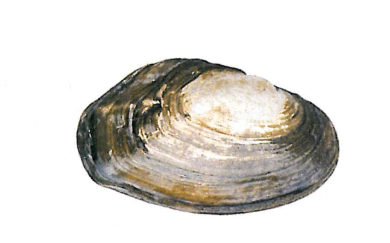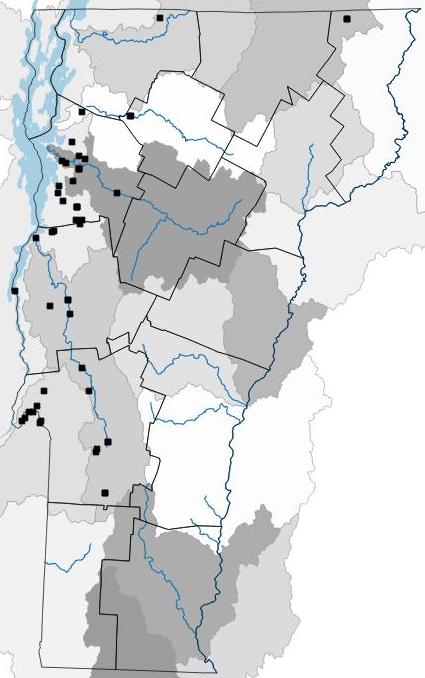 The creek heelsplitter is found in the Canadian Interior Basin, the upper Mississippi, Ohio and St. Lawrence River systems extending from Saskatchewan to Nebraska and eastward to Vermont and Quebec. It was first documented in Vermont by Adams (1841).
The creek heelsplitter is found in the Canadian Interior Basin, the upper Mississippi, Ohio and St. Lawrence River systems extending from Saskatchewan to Nebraska and eastward to Vermont and Quebec. It was first documented in Vermont by Adams (1841).
Key Characteristics
- Size: Length up to 5 inches
- Shape: Elongate or oblong and squared off at the posterior edge. The shell is compressed.
- Periostracum: Greenish-brown or brown with green rays. The inside of the shell is usually white, but it can be cream or salmon colored.
- Lateral Teeth: Somewhat developed
- Pseudocardinal Teeth: Somewhat reduced
- Nacre: White, cream, or light pink
- Similar Species: Fluted shell
Conservation Status
- State and Global Rank: S2 G5
- Vermont Wildlife Action Plan: Species of Greatest Conservation Need
- Vermont Endangered Species Law: not listed
- U.S. Endangered Species Act: not listed
- IUCN Red List: Least Concern
Habitat
Usually found in creeks, smaller rivers, and upstream areas in large rivers. This species prefers finer gravel, sand, and mud.
Host Species
Slimy sculpin, spotfin shiner, black crappie, and the yellow perch.
More information
- Encyclopedia of Life
- NatureServe
- Musselp
- iNaturalist species page
Range
Most records are from the Champlain basin. In 1993 it was discovered in the Coaticook River in Norton in northeastern Vermont, a tributary of the St. Francis River, which enters the St. Lawrence River. It is found in Otter Creek in nearly to the headwaters.
Distribution map has locations where this species has been documented and digitized into the atlas database. Systematic surveys have not been conducted for many species and those surveys that have been conducted have been largely focused on endangered species. Therefore, in some cases, the actual distribution of freshwater mussels may be more extensive than what is presented here. Shaded areas are watershed sub-basins and river main stems are shown.







